Calapooia Roundup
Crawfordsville, Oregon
by
Mona Hyer Waibel
![]()
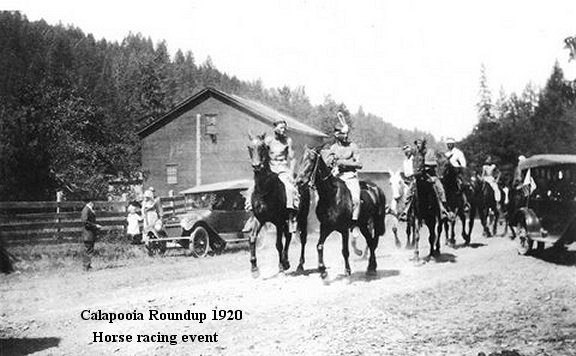 The thunder of hooves from galloping horses, whipped on by grinning whooping cowboys, great rodeo stock, interested saddle
clubs, and a perfect location on the banks of the
Calapooia River– gave us the Crawfordsville
Roundup. It all began in 1920, a
logical idea for an area that was stocked with horses and skilled
horsemanship. My memories of the Calapooia Roundup are
plentiful. That first Roundup in 1920 was attended by
locals of the Crawfordsville,
Brownsville and Sweet
Home area. The celebration gave friends
an opportunity to meet, visit and engage in fast sports related to horses and
prowess in competition.
The thunder of hooves from galloping horses, whipped on by grinning whooping cowboys, great rodeo stock, interested saddle
clubs, and a perfect location on the banks of the
Calapooia River– gave us the Crawfordsville
Roundup. It all began in 1920, a
logical idea for an area that was stocked with horses and skilled
horsemanship. My memories of the Calapooia Roundup are
plentiful. That first Roundup in 1920 was attended by
locals of the Crawfordsville,
Brownsville and Sweet
Home area. The celebration gave friends
an opportunity to meet, visit and engage in fast sports related to horses and
prowess in competition.
The incredible arena and quarter-mile track
was in the heart of a natural terrace, surrounded by fir-clad hills. The workers here had grubbed out all the oaks
and firs from the present arena and track and made a great place to hold a
rip-snorting rodeo. Many of the rodeo competitors came from
active saddle clubs in the valley - Brownsville Foothills Riders, Harrisburg
Prairie Riders, Sweet Home Timber Riders, Halsey Saddle Club, Scio Buckaroos,
Philomath Saddle Club and the Linn County Mounted Posse – both for senior and
junior members. They competed in western games and rode in
parades and were so happy to have the Roundup to ride with the best
horsemen. Many people owned horses and
rode the trails often. My husband Bob and I rode with the Foothill Riders.
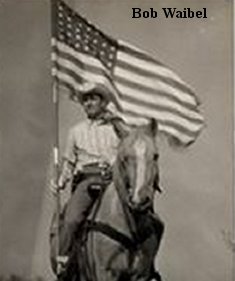
By the 1950’s, times were prosperous for the first time in years. The bad effects of World War II were over and many soldiers were returning to eastern Linn County for jobs in the vast woods of Oregon. There would be money again for fun things. During the 1950’s, my husband-to-be Bob Waibel and his three brothers, Bud, Joe and Jim Waibel, from the Waibel Ranch on Northern Drive in Brownsville, all were taking part in the cowboy events of this two day affair. The Calapooia Roundup was one of the outstanding rodeo attractions of western Oregon. It was held in Crawfordsville, on the banks of the picturesque river. My family remembers well that if you waded the river from down by the bridge, “You didn’t hafta pay to get in.”
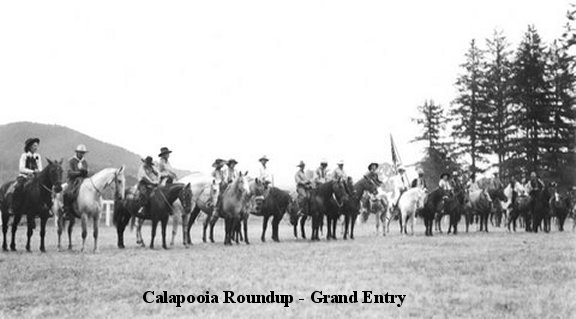 The Waibels rode
their ponies into the Grand Entry and anyone doing this didn’t have to pay
either. The Grand Entry took the entire group of freshly brushed horses and
spiffy riders right through the arena and past the grandstand. It was an exciting tribute to the good
horsemanship of the day, despite the cloud of dust that swirled after each.
The Waibels rode
their ponies into the Grand Entry and anyone doing this didn’t have to pay
either. The Grand Entry took the entire group of freshly brushed horses and
spiffy riders right through the arena and past the grandstand. It was an exciting tribute to the good
horsemanship of the day, despite the cloud of dust that swirled after each.
There was money to be made that weekend. The purse of prize money was good and profitable for those who were quick and persistent. Bronc riding, calf roping, bull dogging, and bareback racing all paid $150 for first place. There was a Grand Mounted Parade daily. The Waibel brothers mostly enjoyed the fast-paced horse races and spurred their ponies into winning many prizes. I remember that some of the Warm Springs Indians as well as the Pendleton tribe came in their full regalia and put on quite a show for the boisterous crowds. Their beaded costumes were incredible and the leather was probably very warm on those summer days.
June 17- 18, 1950 was a good weekend for a rodeo. And earlier in the day, the tribal Indians rode the parade in the back of a truck as the crowd watched the Pioneer Picnic parade go through the streets of Brownsville. The Brownsville High School band sat in the bleachers and played their special music for the Roundup. Bob Waibel played in the band also, but preferred to ride his horse in this event. The crowds poured into the stands and the cowboys kept their horses reined in to keep them all from running around the dirt race track that awaited the horse racing to begin later in the day. In 1949, the rodeo was on the 4th of July. To support the Albany Timber Carnival, the date was changed to June and complemented the Brownsville Pioneer Picnic. I found an advertisement in the 1950 rodeo program that asked the crowd to support the Timber Carnival on July 4th, and most people did just that too.
There were great advertisers in the 1950 program: Brown’s Tik-Tok Ice Cream, 1355 Main Street; White’s Café; Santiam Lumber Co. retail yard, phone 1891; Town Club; Red Head Drive- In Café; Braden’s Store Ready To Wear; White’s Furniture; Max Landon Real Estate - Insurance; Ashton’s Feed Store; Roberts Men’s Clothes; Dave Epps Furniture; Nieman’s Tavern, Crawfordsville; Cardwell’s Department Store, which gave out Green Stamps; Roth’s Auctions in Albany.
Bill Markley came to put on a show for the spectators with his clown act, fun antics and, of course, his prowess at keeping the cowboys safe when a bull went after him. No wonder the announcer told the crowd “No firecrackers allowed on the grounds.” Animals could be frightened by the pop of firecrackers and might bolt and cause accidents.
Not only were there horses and riders, but
families came with their boats tied up along the river banks. There were some
good fishing holes and lots of good outdoor activities going on at the rodeo
grounds. There was free camping and
swimming along with the fishing. 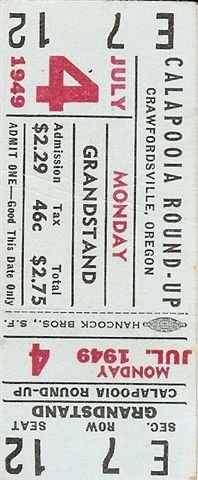
The rodeo grounds were very busy during the Roundup. The bleachers were full of paying customers who each paid $2.50 for reserved seats or $1.50 for bleacher seats, and kids paid 50 cents admission. $12,000 was taken in at the admission gate. The seating capacity held 6,000 screaming spectators who found rodeos very exciting. The crude bleachers were made of scrap lumber, but no one complained. About 1923 the workers floored the old lumber mill on the grounds and transformed it into a great dance hall and a barn for the livestock. Things were really good for the rodeo future.
In 1947 the well-used dance hall was
destroyed by a fire. Later a new
grandstand and a concrete dance pavilion were built and used for more events
than just the rodeo weekend. Dances were held after each rodeo performance and
several times during the year to bring in start-up cash for the rodeo. Good
music was supplied by bands that were paid after each dance. $217 was an average
take at the door for these great dances. A well-known band from Vida was paid $140
per evening during the rodeo. In September 1949 several dances were held around
hunting season, with the Oregon Ramblers playing their music. A letter from
rodeo Secretary Frances Powers asked Lester Porter to put advertisements in the
local papers and not to forget
Eugene papers. 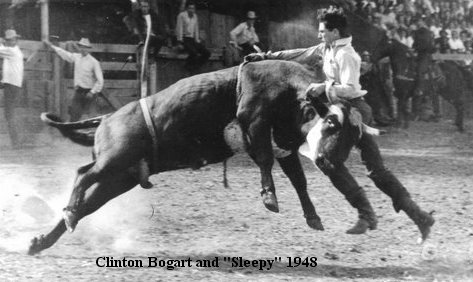
Memorable happenings went on at these
rodeo grounds. The traditions of the old West were preserved and the events
provided an opportunity for cowboys to display their skills and horsemanship to
a good crowd. The steers, calves and all
the stock were supplied by the Christiansen Brothers, Bob and Hank of Eugene.
The two brothers were pick-up men who took the cowboys off the broncs after finishing their rides. The brothers were also
noted for wearing red initials CB on their white chaps. This ranch was one of the nation’s largest
rodeo livestock contractors and was well known for supplying great bulls and
broncs for rodeos all over the Northwest. They were
paid $2,750 for use of their stock in 1950. I understand they retired from
raising rodeo stock. What a loss! When Bob Waibel helped with the first
revised Sportsman’s Holiday Calapooia Rodeo in Sweet home, years later, in 1983,
Sombrero Stock provided the stock used for the cost of $9100. That year the
expenses outweighed the income. 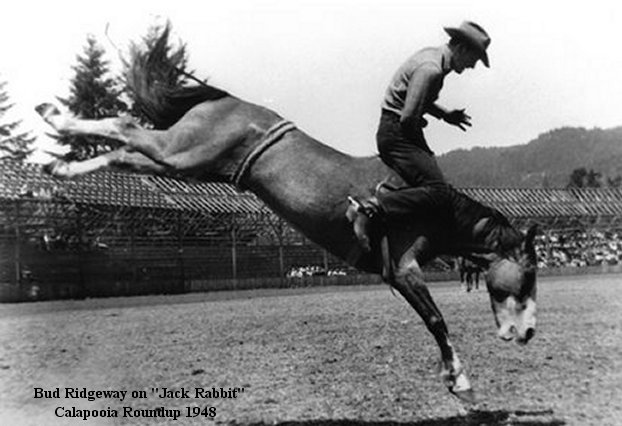
The rodeo today is held at the Outdoor Events Center on Long Street. And we are so pleased the NPRA Rodeo lives on in Sweet Home and doing financially well. They have support today from SHEDG and all the community too. Today it is called the Sweet Home Rodeo.
Many of the early directors and planners of the early Calapooia Roundup were really into cowboy walk and talk. Fred Enos decked out in a white Stetson and crisp cowboy shirt with pearl snaps, and his efficient wife Blake helped to make this a great celebration. Blake shared a packet full of old vouchers and programs for me to help me write this story. Thank you, Blake. Warren Isom was president of the Rodeo Association, and Shy Huntington worked on races, was flag man during calf roping and responsible for getting judges in the arena too. He was a busy man. Wayne Braden was another local name I remember. He was a director also.
Barbara Huntington, who hailed from Eugene, came to do some Trick & Fancy riding for the crowd. She was a beautiful talented young woman. She performed on her famous steed, in a daring side-saddle stance that thrilled spectators. Trick & Fancy usually included tricks as they rode through the arena. One favorite was the rider standing in the stirrups with their hands in the air waving, and head held high. Another trick had the rider’s head hanging to the ground as he or she sped past the crowd. My favorite was always the Roman event, where one man rode two horses with a foot in the stirrups of each, riding the horses side by side, a very dangerous event but exciting too. I also liked the bareback races, and cheered for the winners. 1950’s rodeo was an exciting year.
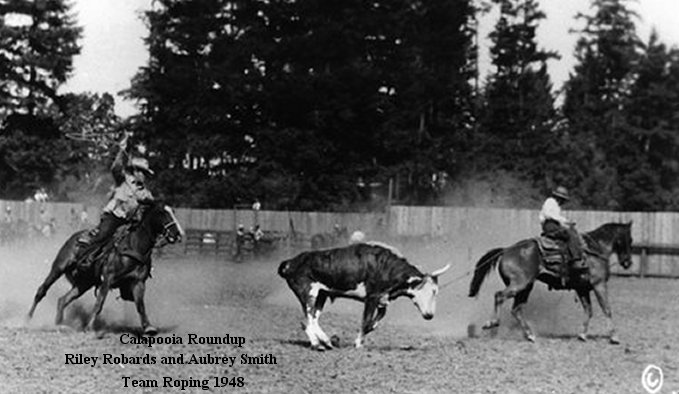 Men were performing fancy roping, the
Texas Skip with 50
feet of rope while in the saddle. Bob Waibel practiced and became quite good at
this skill at age 16. Ten-year-old Jim
Waibel won 1st place in the kids’ event and $4 prize money. The Bank of Shedd held the bank account for
the Calapooia Roundup Association.
Men were performing fancy roping, the
Texas Skip with 50
feet of rope while in the saddle. Bob Waibel practiced and became quite good at
this skill at age 16. Ten-year-old Jim
Waibel won 1st place in the kids’ event and $4 prize money. The Bank of Shedd held the bank account for
the Calapooia Roundup Association.
The queen of the 34th year was Mildred McReynolds, daughter of Roscoe McReynolds from Brownsville. She was raised in Linn County and has been an active part of past rodeos. Two lovely princesses rode beside her: Ruth Davis and Alice Lovejoy. U.S. Senator Wayne Morse couldn’t make it to the 1950 rodeo and sent his regrets, because it was election year in Washington D.C. The records from the event also include a statement from the Crawfordsville Mutual Telephone Co. for an $8.12 phone bill during the rodeo, which included a smashed phone and several long distance calls, and a bill for $47.34 from The New Era for advertising in May and June and 300 rodeo programs. Bill Dudley and A.E. Macoubrie, two brothers-in-law, owned the newspaper.
Some special memories: My cousin Ben Gedney won the All Around Cowboy award and belt buckle during the 1940’s. He lost his life in World War II. Homer Simms ran fast race horses in those early days. Blake Enos’s sister, Chris Christensen, ran for queen during the 1930’s and lost in a close race to Zel Gilbert. I remember how Blake Christensen Enos pitched her tent at the Roundup and after the dance she went quietly to bed. A few guys from Shedd cut the tent ropes and the tent fell with her inside.
Years later Fred and Blake were at a big dance after the Roundup. Men were drinking and fighting. The Enoses watched from their car bumper, a safe place to watch Knute from Shedd and Geil punch it out. Notoriously, there were many fights at the dances; some came to watch the fist-fighting but mostly they finished with a handshake and a slap on the back to end it all.
Time did wear out the idea of rodeos for Crawfordsville and I am not sure why, but in the 1950’s it all came to an end. We think 1953 was the last rodeo performed. Several years later the arena was used for good horse shows for the locals. On June 5, 1955, The Linn County Junior Mounted Posse staged a great play day horse show here in the arena. It was the final horse event held here. Bob Waibel, then 21, competed that day, and he has the one trophy that was given then, for “The Cowboy of the Day.”
The1956 Elks Picnic was held at the Rodeo grounds. We all sat in the bleachers and had our chicken dinners. Soon the grounds were sold and the bleachers were torn down. Today the area where the great rodeo was held has many trees grown up through the arena and it is now used for other purposes.
The end of a splendid memory.
![]()
My name is Stephenie Flora. Thanks for stopping by. Return to [ Home Page ] All [ Comments and Inquiries ] are welcome.